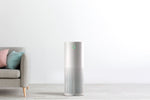What Does a Dehumidifier Do? Improve Your Home’s Air Quality and Comfort
What Does a Dehumidifier Do? A Complete Guide
Have you ever walked into a room and felt sticky, heavy air clinging to your skin? That’s the result of excess humidity. A dehumidifier offers a solution by pulling in the humid air, extracting the moisture, and releasing dry, fresh air back into your space. While this process is essential for managing humidity, it’s important to understand how it fits into the broader picture of maintaining a healthy, breathable indoor environment.

In this guide, we’ll cover:
• How a dehumidifier works
• How to use it effectively
• Common sources of humidity in your home
• The risks associated with high humidity
• Why combining a dehumidifier with a high-quality air purifier, like Jaspr, offers the most complete solution
How Does a Dehumidifier Work?
Dehumidifiers operate by reducing the moisture content in the air. Here’s how it works:
1. Drawing in Humid Air
Using a fan, the dehumidifier pulls in humid air but focuses specifically on reducing the moisture content, not filtering out particles like dust or allergens.
2. Condensation Process
As the air moves through the dehumidifier’s cooling coils, the moisture condenses into water droplets. These droplets are collected in a reservoir or automatically drained in some models.
3. Releasing Dry Air
The now drier air is slightly warmed and released back into the room, making your space more comfortable.
4. Managing Moisture Levels
By continuously pulling in moist air and releasing dry air, a dehumidifier can lower the humidity in your space to an ideal range of 45-55%.
While dehumidifiers are effective in tackling humidity, they don’t address other air quality issues like allergens, dust, mold spores, and pollen, which is where an air purifier comes in.
How to Use a Dehumidifier Effectively
To get the most out of your dehumidifier, follow these guidelines:
1. Choose the Right Size
Select a dehumidifier that matches the size of your space. Smaller units are suitable for bathrooms, while larger rooms or basements need higher-capacity units.
2. Position it Correctly
Place your dehumidifier in the most humid areas, such as near damp walls or in basements, but ensure it’s not obstructed by furniture or walls for proper airflow.
3. Monitor Humidity Levels
Aim to maintain a humidity level between 45-55%. Many modern dehumidifiers have built-in hygrometers to help you track and adjust the humidity accordingly.
4. Empty the Water Reservoir
If your unit doesn’t have automatic drainage, empty the water tank regularly to prevent overflow.
5. Clean the Filters
Clean or replace filters regularly to ensure your dehumidifier operates at peak efficiency.
6. Use in Moderation
Avoid overusing a dehumidifier. Excessively dry air can cause health issues like dry skin, irritated sinuses, and respiratory discomfort.
The Risks of Excess Humidity
High humidity in your home can lead to several problems, including:
• Mold Growth
Mold thrives in humid environments and can grow on carpets, walls, and even in your air ducts, posing serious health risks.
• Dust Mites
These microscopic creatures love damp environments and can exacerbate asthma and allergies.
• Respiratory Issues
High moisture in the air can irritate airways and worsen respiratory conditions, especially for those with asthma or allergies.
• Damage to Interiors
Excess humidity can warp wood, peel wallpaper, and damage furniture and floors.
• Musty Smells
Damp environments often produce musty odors. While a dehumidifier helps, pairing it with an air purifier like Jaspr, equipped with activated carbon filters, can eliminate odors and purify the air.
The Importance of Combining a Dehumidifier with an Air Purifier
While dehumidifiers are excellent at controlling moisture, they don’t address other pollutants like dust, mold spores, or allergens. This is where a high-quality air purifier, like Jaspr, comes into play.
An air purifier complements a dehumidifier by filtering out harmful particles that linger in the air. Whether you’re dealing with allergens, mold spores, pollen, or even toxic chemicals that can hitch a ride on dust, Jaspr’s advanced filtration system ensures that your indoor air remains clean and breathable.
For many situations, such as preventing mold growth, improving respiratory health, or eliminating odors, an air purifier can actually be a more practical solution than a dehumidifier alone. A Jaspr air purifier doesn’t just manage moisture—it actively cleans the air, creating a healthier environment for you and your family.
Final Thoughts
Balancing humidity in your home is essential for a healthy and comfortable living environment. While a dehumidifier helps control moisture and prevents problems like mold growth and musty odors, it’s only part of the equation. To fully improve your indoor air quality, pairing a dehumidifier with a high-quality air purifier, like Jaspr, is the best solution.
Jaspr air purifiers go beyond moisture control, removing harmful pollutants such as mold spores, dust, allergens, and toxic particles that a dehumidifier can’t address. With Jaspr, you get cleaner, fresher air while maintaining optimal humidity levels. It’s the winning combination for a healthier home.
FAQs
What humidity level should I set for my dehumidifier?
You should aim to keep indoor humidity between 45% and 55%. This range helps prevent mold growth and reduces allergens without making the air too dry.
Can using a dehumidifier cause dry air problems?
Yes, overusing a dehumidifier can cause the air to become too dry, leading to issues such as dry skin, irritated sinuses, and throat discomfort. That’s why it’s important to monitor humidity levels.
Should I use a dehumidifier and air purifier together?
Absolutely. While a dehumidifier controls moisture, it doesn’t filter out pollutants like mold spores, dust, or allergens. An air purifier, especially a high-quality one like Jaspr, actively removes these harmful particles from the air. In many cases, an air purifier is actually the more practical solution, providing a comprehensive approach to cleaner, healthier air.
Is an air purifier like Jaspr a better option than a dehumidifier?
For many air quality concerns, yes. A commercial-grade air purifier like Jaspr not only removes moisture-related pollutants like mold spores but also tackles dust, pollen, and allergens, which a dehumidifier cannot address. It’s often a more effective and versatile solution for improving overall indoor air quality.
Back to Blog


